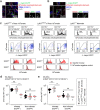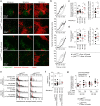Ly6G deficiency alters the dynamics of neutrophil recruitment and pathogen capture during Leishmania major skin infection
- PMID: 34302006
- PMCID: PMC8302578
- DOI: 10.1038/s41598-021-94425-9
Ly6G deficiency alters the dynamics of neutrophil recruitment and pathogen capture during Leishmania major skin infection
Abstract
Neutrophils represent one of the first immune cell types recruited to sites of infection, where they can control pathogens by phagocytosis and cytotoxic mechanisms. Intracellular pathogens such as Leishmania major can hijack neutrophils to establish an efficient infection. However the dynamic interactions of neutrophils with the pathogen and other cells at the site of the infection are incompletely understood. Here, we have investigated the role of Ly6G, a homolog of the human CD177 protein, which has been shown to interact with cell adhesion molecules, and serves as a bona fide marker for neutrophils in mice. We show that Ly6G deficiency decreases the initial infection rate of neutrophils recruited to the site of infection. Although the uptake of L. major by subsequently recruited monocytes was tightly linked with the concomitant uptake of neutrophil material, this process was not altered by Ly6G deficiency of the neutrophils. Instead, we observed by intravital 2-photon microscopy that Ly6G-deficient neutrophils entered the site of infection with delayed initial recruitment kinetics. Thus, we conclude that by promoting neutrophils' ability to efficiently enter the site of infection, Ly6G contributes to the early engagement of intracellular pathogens by the immune system.
© 2021. The Author(s).
Conflict of interest statement
The authors declare no competing interests.
Figures



Similar articles
-
The Impact of Neutrophil Recruitment to the Skin on the Pathology Induced by Leishmania Infection.Front Immunol. 2021 Mar 1;12:649348. doi: 10.3389/fimmu.2021.649348. eCollection 2021. Front Immunol. 2021. PMID: 33732265 Free PMC article. Review.
-
TLR2 Signaling in Skin Nonhematopoietic Cells Induces Early Neutrophil Recruitment in Response to Leishmania major Infection.J Invest Dermatol. 2019 Jun;139(6):1318-1328. doi: 10.1016/j.jid.2018.12.012. Epub 2018 Dec 27. J Invest Dermatol. 2019. PMID: 30594488 Free PMC article.
-
CCL7 Is a Negative Regulator of Cutaneous Inflammation Following Leishmania major Infection.Front Immunol. 2019 Jan 8;9:3063. doi: 10.3389/fimmu.2018.03063. eCollection 2018. Front Immunol. 2019. PMID: 30671055 Free PMC article.
-
Galectin-3 facilitates neutrophil recruitment as an innate immune response to a parasitic protozoa cutaneous infection.J Immunol. 2013 Jan 15;190(2):630-40. doi: 10.4049/jimmunol.1103197. Epub 2012 Dec 14. J Immunol. 2013. PMID: 23241887
-
Permissive and protective roles for neutrophils in leishmaniasis.Clin Exp Immunol. 2015 Nov;182(2):109-18. doi: 10.1111/cei.12674. Epub 2015 Aug 28. Clin Exp Immunol. 2015. PMID: 26126690 Free PMC article. Review.
Cited by
-
Bioactivated scaffolds promote angiogenesis and lymphangiogenesis for dermal regeneration in vivo.J Tissue Eng. 2025 Mar 12;16:20417314251317542. doi: 10.1177/20417314251317542. eCollection 2025 Jan-Dec. J Tissue Eng. 2025. PMID: 40078220 Free PMC article.
-
Comprehensive proteomic analysis of the differential expression of 62 proteins following intracortical microelectrode implantation.Sci Rep. 2024 Jul 30;14(1):17596. doi: 10.1038/s41598-024-68017-2. Sci Rep. 2024. PMID: 39080300 Free PMC article.
-
Dual role of CD177 + neutrophils in inflammatory bowel disease: a review.J Transl Med. 2024 Sep 2;22(1):813. doi: 10.1186/s12967-024-05539-3. J Transl Med. 2024. PMID: 39223577 Free PMC article. Review.
-
A Comparative Study of Different Protocols for Isolation of Murine Neutrophils from Bone Marrow and Spleen.Int J Mol Sci. 2023 Dec 8;24(24):17273. doi: 10.3390/ijms242417273. Int J Mol Sci. 2023. PMID: 38139101 Free PMC article.
-
Neutrophils as a potential therapeutic target in Alzheimer's disease.Front Immunol. 2023 Mar 3;14:1123149. doi: 10.3389/fimmu.2023.1123149. eCollection 2023. Front Immunol. 2023. PMID: 36936930 Free PMC article. Review.
References
Publication types
MeSH terms
Substances
LinkOut - more resources
Full Text Sources
Molecular Biology Databases

